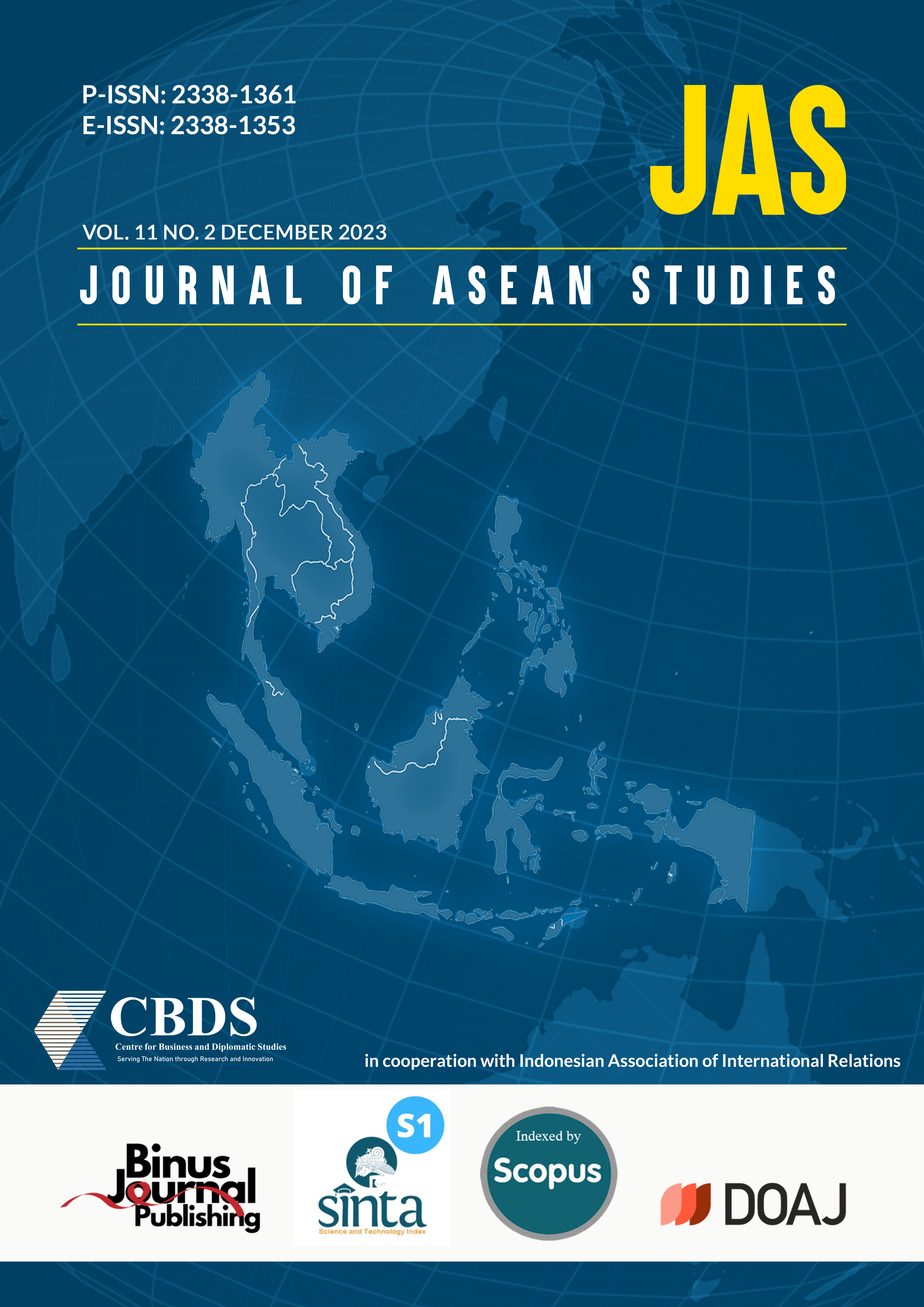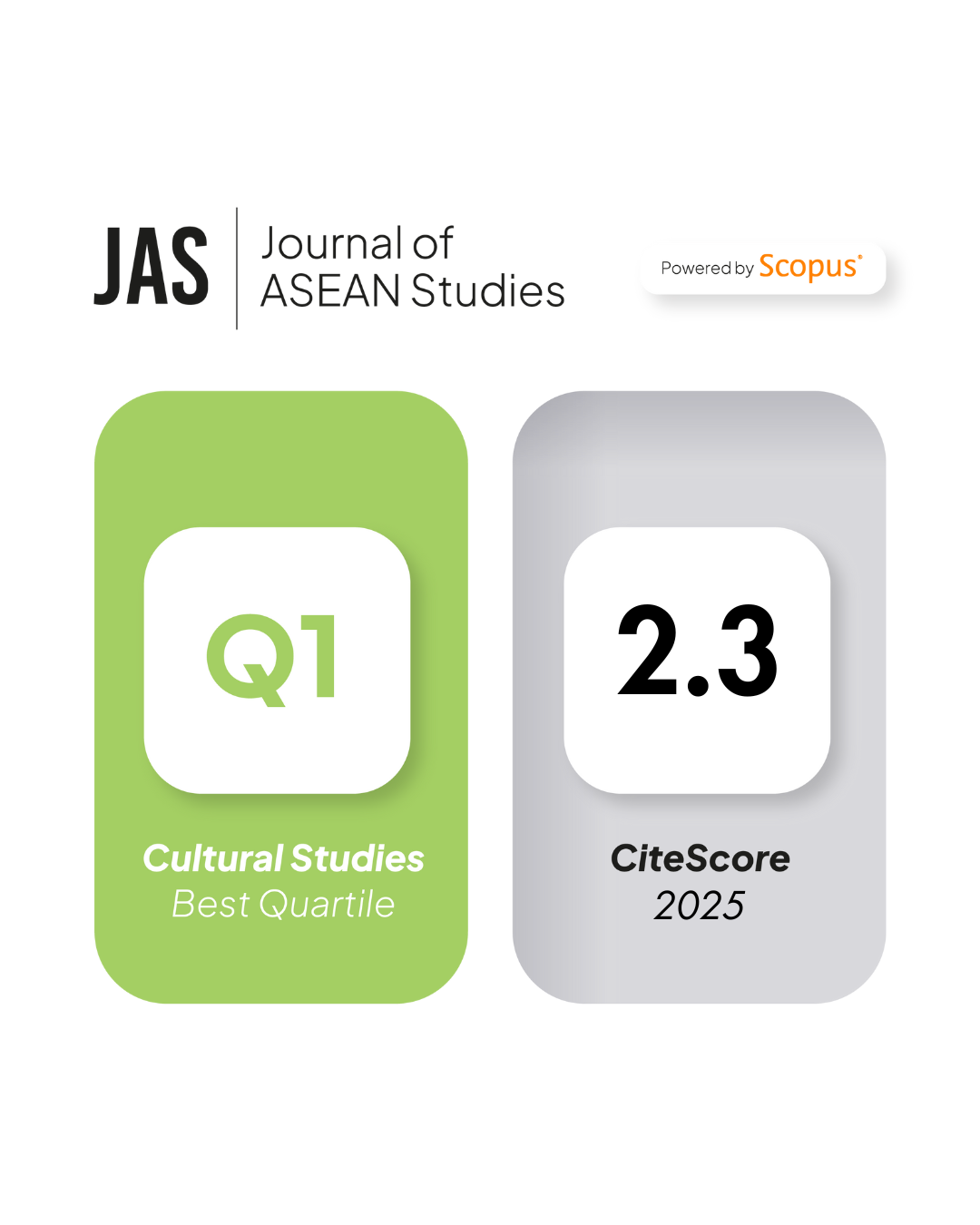Interrelationship Between Macroeconomic Variables With Insurance Premiums and Claims – Lessons For Indonesia & ASEAN
DOI:
https://doi.org/10.21512/jas.v11i2.10214Keywords:
insurance sector, premium & claim, macroeconomic condition, panel-data estimationAbstract
The insurance sector plays a crucial economic role by helping individuals and businesses manage risks and uncertainties. By transferring some of their risks to insurance companies, individuals and companies can reduce the likelihood of bankruptcy compared to bearing the risks themselves. This role has become increasingly important in recent decades, particularly due to climate change, financial crises, and the COVID-19 pandemic, leading to greater volatility in macroeconomic indicators. Understanding these potential risks is key to ensuring the future sustainability and growth of the insurance sector in both Indonesia and ASEAN. The research objective is to examine the relationship between macroeconomic variables and insurance and claims. Using annual panel data regression analysis, we examine the relationship between macroeconomic indicators and insurance gross premiums in a sample of 63 countries from 2010 to 2019. The macroeconomic indicators used in the model are real Gross Domestic Product (GDP), inflation, interest rates, and exchange rates. The results suggest that macroeconomic variables play a significant role in determining the performance of gross premiums and claims. Lessons learned include that real GDP, inflation, and real interest rates show a positive and significant relationship with gross premiums, while exchange rates show a negative relationship. However, the lasting impact of these macroeconomic variables on gross premiums varies from one to the other. In fact, only two variables, real GDP and inflation, have a lasting impact. The results suggest that market players should provide strong and comprehensive risk management systems to address macroeconomic turbulence. Surveillance and monitoring macroeconomic indicators are essential, especially in a macro-dependent sector.
References
Abhijit, M., & Amlan, G. (2022). Role of economic factors in property liability insurance consumption: Empirically examining the Indian market. Studies in Business and Economics, 17(1), 112–129. https://doi.org/10.2478/sbe-2022-0008
Arellano, M. (1987). Computing robust standard errors for within-groups estimators. Oxford Bulletin of Economics and Statistics, 49(4), 431–434. https://doi.org/10.1111/j.1468-0084.1987.mp49004006.x
Baluch, F., Mutenga, S., & Parsons, C. (2011). Insurance, systemic risk, and the financial crisis. The Geneva Papers on Risk and Insurance-Issues and Practice, 36, 126–163. https://doi.org/10.1057/gpp.2010.40
Beck, T., & Webb, I. (2003). Economic, demographic, and institutional determinants of life insurance consumption across countries. The World Bank Economic Review, 17(1), 51–88. https://doi.org/10.1093/wber/lhg011
Beenstock, M., Dickinson, G., & Khajuria, S. (1988). The relationship between property-liability insurance premiums and income: An international analysis. The Journal of Risk and Insurance, 55(2), 259–272. https://doi.org/10.2307/253327
Browne, M., & Kim, K. (1993). An international analysis of life insurance demand. The Journal of Risk and Insurance, 60(4), 616–634. https://doi.org/10.2307/253382
Browne, M. J., Chung, J. W., & Frees, E.W. (2000). International property-liability insurance consumption. The Journal of Risk and Insurance, 67(1), 73–90. https://doi.org/10.2307/253677
Campbell, R. A. (1980). The demand for life insurance: An application of the economics of uncertainty. The Journal of Finance, 35(5), 1155–1172. https://doi.org/10.1111/j.1540-6261.1980.tb02201.x
Colquitt, L. L., & Hoyt, R. E. (1997). Determinants of corporate hedging behavior: Evidence from the life insurance industry. The Journal of Risk and Insurance, 64(4), 649–671. https://doi.org/10.2307/253890
Cummins, J. D., Lewis, C. M., & Phillips, R. D. (1999). Pricing excess-of-loss reinsurance contracts against cat as trophic loss. In K. A. Froot (Ed.), The financing of catastrophe risk (pp. 93–148). University of Chicago Press.
Cummins, J. D., & Weiss, M. A. (2014). Systemic risk and the U.S. insurance sector. Journal of Risk and Insurance, 81(3), 489–528. https://doi.org/10.1111/jori.12039
Dragos, S. L. (2014). Life and non-life insurance demand: The different effects of influence factors in emerging countries from Europe and Asia. Economic Research-Ekonomska Istraživanja, 27(1), 169–180. https://doi.org/10.1080/1331677x.2014.952112
Dragos, S. L., Mare, C., Dragota, I. M., Dragos, C. M., & Muresan, G. M. (2017). The nexus between the demand for life insurance and institutional factors in Europe: New evidence from a panel data approach. Economic Research-Ekonomska Istraživanja, 30(1), 1477–1496. https://doi.org/10.1080/1331677x.2017.1325764
Dragoş, S. L., Mare, C. & Dragoş, C. M. (2019). Institutional drivers of life insurance consumption: A dynamic panel approach for European countries. The Geneva Papers on Risk and Insurance - Issues and Practice, 44, 36–66. https://doi.org/10.1057/s41288-018-0106-3
Dragotă, I. M., Cepoi, C. O., & Ştefan, L. (2023). Threshold effect for the life insurance industry: Evidence from OECD countries. The Geneva Papers on Risk and Insurance - Issues and Practice, 48, 799–820. https://doi.org/10.1057/s41288-022-00272-8
Esho, N., Kirievsky, A., Ward, D., & Zurbruegg, R. (2004). Law and the determinants of property-casualty insurance. Journal of Risk and Insurance, 71(2), 265–283. https://doi.org/10.1111/j.0022-4367.2004.00089.x
Feyen, E., Lester, R., & Rocha, R. (2011, February). What drives the development of the insurance sector? An empirical analysis based on a panel of developed and developing countries. The World Bank. https://openknowledge.worldbank.org/bitstream/handle/10986/3339/WPS5572.pdf?sequence=4&isAllowed=y
Fortune, P. (1973). A theory of optimal life insurance: Development and test. The Journal of Finance, 28(3), 587–600. https://doi.org/10.2307/2978631
Froot, K. A. (1989). Consistent covariance matrix estimation with cross-sectional dependence and heteroskedasticity in financial data. The Journal of Financial and Quantitative Analysis, 24(3), 333–355. https://doi.org/10.2307/2330815
Haiss, P., & Sümegi, K. (2008). The relationship between insurance and economic growth in Europe: a theoretical and empirical analysis. Empirica, 35, 405-431. https://doi.org/10.1007/s10663-008-9075-2
Hosseinzadeh, M., & Daei-Karimzadeh, S. (2017). Investigate the effect of exchange rate volatility on demand for life insurance in Iran. International Journal of Economics and Financial Issues, 7(2), 166–174.
Huber, P. J. (1967). The behavior of maximum likelihood estimates under nonstandard conditions. In Proceedings of the Fifth Berkeley Symposium on Mathematical Statistics and Probability (pp. 221–233).
IFG. (2022). Nexus antara variabel makroekonomi terhadap premium dan klaim industri asuransi - Perbandingan antar negara. Unpublished manuscript.
Kjosevski, J. (2012). The determinants of life insurance demand in Central and Southeastern Europe. International Journal of Economics and Finance, 4(3), 237–247. https://doi.org/10.5539/ijef.v4n3p237
Lewis, F. D. (1989). Dependents and the demand for life insurance. The American Economic Review, 79(3), 452–467.
Li, D., Moshirian, F., Nguyen, P., & Wee, T. (2007). The demand for life insurance in OECD countries. Journal of Risk and Insurance, 74(3), 637–652. https://doi.org/10.1111/j.1539-6975.2007.00228.x
Li, D., Moshirian, F., Wee, T., & Wu, E. (2009). Foreign exchange exposure: Evidence from the U.S. insurance industry. Journal of International Financial Markets, Institutions and Money, 19(2), 306–320. https://doi.org/10.1016/j.intfin.2008.01.003
McKinsey & Company. (2022, February 15). Creating value, finding focus: Global insurance report 2022. https://www.mckinsey.com/industries/financial-services/our-insights/creating-value-finding-focus-global-insurance-report-2022
Menegatti, M., & Rebessi, F. (2011). On the substitution between saving and prevention. Mathematical Social Sciences, 62(3), 176–182. https://doi.org/10.1016/j.mathsocsci.2011.09.002
Millo, G., & Carmeci, G. (2010). Non-life insurance consumption in Italy: A sub-regional panel data analysis. Journal of Geographical Systems, 13, 273–298. https://doi.org/10.1007/s10109-010-0125-5
OECD. (2023, May 31). OECD insurance statistics 2022. OECD iLibrary. https://doi.org/10.1787/0512c106-en
Olarewaju, O., & Msomi, T. (2021). Determinants of insurance penetration in West African countries: A panel Auto Regressive Distributed Lag Approach. Journal of Risk and Financial Management, 14(8), 1–15. https://doi.org/10.3390/jrfm14080350
Olasehinde-Williams, G., & Balcilar, M. (2020). Examining the effect of globalization on insurance activities in large emerging market economies. Research in International Business and Finance, 53. https://doi.org/10.1016/j.ribaf.2020.101228
Otoritas Jasa Keuangan. (2021, November 19). Statistik perasuransian 2020. https://ojk.go.id/id/kanal/iknb/data-dan-statistik/asuransi/Pages/Statistik-Perasuransian-2020.aspx
Outreville, J. F. (1996). Life insurance markets in developing countries. The Journal of Risk and Insurance, 63(2), 263–278. https://doi.org/10.2307/253745
Park, S., & Lemaire, J. (2011). Culture matters: Long-term orientation and the demand for life insurance. Asia-Pacific Journal of Risk and Insurance, 5(2). https://doi.org/10.2202/2153-3792.1105
Redzuan, H., Rahman, Z. A., Sakinah, S., & Adid, S. H. (2009). Economic determinants of family takaful consumption: Evidence from Malaysia. International Review of Business Research Papers, 5(5), 193–211.
Rogers, W. H. (1993). Regression standard errors in clustered samples. Stata Technical Bulletin 13, 19–23.
Savvides, S. (2006). Inquiry into the macroeconomic and household motives to demand life insurance: Review and empirical evidence from Cyprus. Journal of Business & Society, 19(1/2), 37–79.
Segodi, M. P., & Sibindi, A. B. (2022). Determinants of life insurance demand: Empirical evidence from BRICS countries. Risks, 10(4), 1–14. https://doi.org/10.3390/risks10040073
Sen, S., & Madheswaran, S. (2013). Regional determinants of life insurance consumption: Evidence from selected Asian economies. Asian-Pacific Economic Literature, 27(2), 86–103. https://doi.org/10.1111/apel.12024
Sherden, W. A. (1984). An analysis of the determinants of the demand for automobile insurance. The Journal of Risk and Insurance, 51(1), 49–62. https://doi.org/10.2307/252800
Simionescu, M & Ulbinaitė, A. (2021). The relationship between insurance market and macroeconomic indicators in the Baltic states. Journal of Baltic Studies, 52(3), 373–396, https://doi.org/10.1080/01629778.2021.1920440
Singhal, N., Goyal, S., & Singhal, T. (2020). Insurance–growth nexus: Empirical evidence from emerging Asian markets. Transnational Corporations Review, 12(3), 237–249. https://doi.org/10.1080/19186444.2020.1756170
Siregar, R. Y., Rohman, I. K., & Luviyanto, A. N. (2023, January 16). Hubungan perbankan dan asuransi: Fenomena struktural atau temporal? Indonesia Financial Group. https://ifgprogress.id/wp-content/uploads/2023/01/Econ.-Bulletin-Issue-23-Hubungan-Perbankan-dan-Asuransi-January-2023-1.pdf
Tian, L., Jiang, S. J., Pan, G., & Zhang, N. (2018). Non-life insurance price dynamics: evidence from the Chinese insurance market. Economic Research-Ekonomska Istraživanja, 31(1), 171–187. https://doi.org/10.1080/1331677x.2018.1424557
Treerattanapun, A. (2011). The impact of culture on non-life insurance consumption. Wharton Research Scholars Project, University of Pennsylvania.
Trinh, T., Nguyen, X., & Sgro, P. (2016). Determinants of non-life insurance expenditure in developed and developing countries: An empirical investigation. Applied Economics, 48(58), 5639–5653. https://doi.org/10.1080/00036846.2016.1181834
Truett, D. B., & Truett, L. J. (1990). The demand for life insurance in Mexico and the United States: A Comparative Study. The Journal of Risk and Insurance, 57(2), 321–328. https://doi.org/10.2307/253306
Valckx, N., Chan-Lau, J. A., Feng, A., Huston, B., Impavido, G., Jobst, A. A., ... & Yan, K. (2016). The insurance sector-trends and systemic risk implications. In Global Financial Stability Report. International Monetary Fund.
Ward, D., & Zurbruegg, R. (2002). Law, politics and life insurance consumption in Asia. The Geneva Papers on Risk and Insurance - Issues and Practice, 27, 395–412. https://doi.org/10.1111/1468-0440.00181
White, H. (1980). A heteroskedasticity-consistent covariance matrix estimator and a direct test for heteroskedasticity. Econometrica 48, 817–838. https://doi.org/10.2307/1912934
White, H. (1984). Asymptotic theory for econometricians. Academic Press.
World Bank. (2023, December 20). World development indicators. https://doi.org/10.57966/6rwy-0b07
Zarnowitz, V. (1992). Business cycles: Theory, history, indicators, and forecasting. University of Chicago Press. https://doi.org/10.7208/chicago/9780226978925.001.0001
Zerriaa, M., & Noubbigh, H. (2016). Determinants of life insurance demand in the MENA region. The Geneva Papers on Risk and Insurance - Issues and Practice, 41, 491–511. https://doi.org/10.1057/gpp.2016.1
Downloads
Published
How to Cite
Issue
Section
License
Copyright (c) 2023 Ibrahim Kholilul Rohman, Rizky Ronaldo, Reza Yamora Siregar

This work is licensed under a Creative Commons Attribution-NonCommercial 4.0 International License.






















